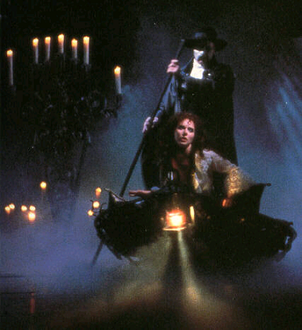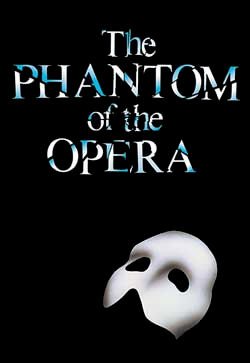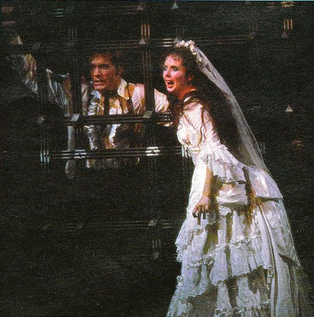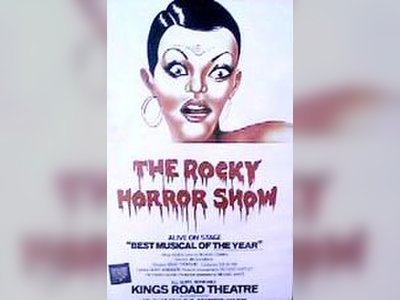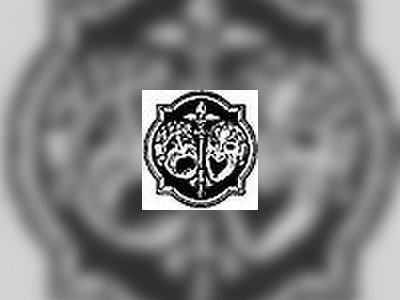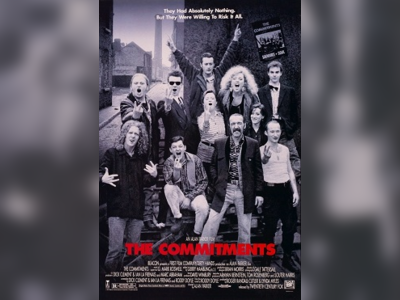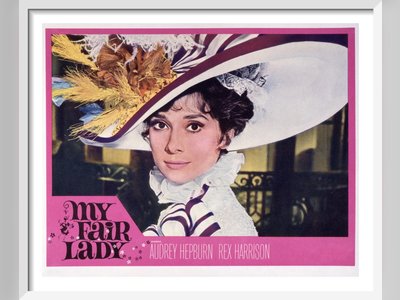The Phantom of the Opera
***TOO LONG***The Phantom of the Opera (1986) is a musical with music by Andrew Lloyd Webber (who co-wrote the libretto alongside Richard Stilgoe) and lyrics by Charles Hart. It is based on the 1910 eponymous French novel by Gaston Leroux. It is the second longest-running West End musical, after Les Misérables, and the third longest-running West End show overall, after The Mousetrap.
The Phantom of the Opera (1986) is a musical with music by Andrew Lloyd Webber (who co-wrote the libretto alongside Richard Stilgoe) and lyrics by Charles Hart. It is based on the 1910 eponymous French novel by Gaston Leroux.
The plot revolves around a beautiful soprano, Christine Daaé, who becomes the obsession of a mysterious, masked musical genius living in the subterranean labyrinth beneath the Paris Opéra House.
The musical opened in London's West End in 1986 and on Broadway in New York in 1988. English classical soprano Sarah Brightman (Lloyd Webber's then-wife) was cast as Christine Daaé. It won the 1986 Olivier Award and the 1988 Tony Award for Best Musical, and Michael Crawford (in the title role) won the Olivier and Tony Awards for Best Actor in a Musical. It is currently the longest running show in Broadway history, and celebrated its 10,000th Broadway performance on 11 February 2012, the first production ever to do so. It is the second longest-running West End musical, after Les Misérables, and the third longest-running West End show overall, after The Mousetrap. A film adaptation directed by Joel Schumacher was released in 2004.
With total estimated worldwide gross receipts of over $6 billion and total Broadway gross of over $1 billion,Phantom was the most financially successful entertainment event until The Lion King surpassed it in 2014. By 2011, it had been seen by over 130 million people in 145 cities across 27 countries.
Idea
In 1984, Lloyd Webber contacted Cameron Mackintosh, the co-producer of Cats and Song and Dance, to propose a new musical. He was aiming for a romantic piece, and suggested Gaston Leroux's book The Phantom of the Opera as a basis. They screened both the 1925 Lon Chaney and the 1943 Claude Rains motion picture versions, but neither saw any effective way to make the leap from film to stage. Later, in New York, Lloyd Webber found a second-hand copy of the original, long-out-of-print Leroux novel, which supplied the necessary inspiration to develop a musical: "I was actually writing something else at the time, and I realised that the reason I was hung up was because I was trying to write a major romantic story, and I had been trying to do that ever since I started my career. Then with the Phantom, it was there!"
Lyricists
Lloyd Webber first approached Jim Steinman to write the lyrics because of his "dark obsessive side", but he declined in order to fulfill his commitments on a Bonnie Tyler album.Alan Jay Lerner was then recruited, but he became seriously ill after joining the project and was forced to withdraw; none of his contributions (mostly involving the song "Masquerade") are credited in the show.Richard Stilgoe, the lyricist for Starlight Express, wrote most of the original lyrics for the production. Charles Hart, a young and then-relatively unknown lyricist, later rewrote many of the lyrics, along with original lyrics for "Think of Me". Some of Stilgoe's original contributions are still present in the final version, however.Phantom is primarily a sung-through musical, however there are scattered lines of spoken dialogue.
Score
Inspired in part by an earlier musical version of the same story by Ken Hill, Lloyd Webber's score is sometimes operatic in style but maintains the form and structure of a musical throughout. The full-fledged operatic passages are reserved principally for subsidiary characters such as Andre and Firmin, Carlotta, and Piangi. They are also used to provide the content of the fictional operas that are taking place within the show itself, viz., Hannibal, Il Muto, and the Phantom's masterwork, Don Juan Triumphant. "Here, Lloyd Webber pastiched various styles from the grand operas of Meyerbeer through to Mozart and even Gilbert and Sullivan." These pieces are often presented as musical fragments, interrupted by dialogue or action sequences in order to clearly define the musical's "show within a show" format.
The musical extracts from the Phantom's opera, "Don Juan Triumphant", heard during the latter stages of the show, are dissonant and modern—"suggesting, perhaps, that the Phantom is ahead of his time artistically".
Design, direction, and choreography
Maria Björnson designed the sets and over 200 costumes, including the elaborate gowns in the "Masquerade" sequence. Her set designs, including the chandelier, subterranean gondola, and sweeping staircase, earned her multiple awards.Hal Prince, director of Cabaret, Candide, Follies, and Lloyd Webber's Evita, directed the production, while Gillian Lynne, associate director and choreographer of Cats, provided the integral musical staging and choreography.
First preview at Sydmonton
A preview of the first act was staged at Sydmonton (Lloyd Webber's home) in 1985, starring Colm Wilkinson (later the star of the Toronto production) as the Phantom, Sarah Brightman as Kristin (later Christine), and Clive Carter (later a member of the London cast) as Raoul. This very preliminary production used Richard Stilgoe's original unaltered lyrics, and many songs sported names that were later changed, such as "What Has Time Done to Me" ("Think of Me"), and "Papers" ("Notes"). The Phantom's original mask covered the entire face and remained in place throughout the performance, obscuring the actor's vision and muffling his voice. Maria Björnson designed the now-iconic half-mask to replace it, and the unmasking sequence was added. Clips of this preview performance were included on the DVD of the 2004 film production.
West End (Original Production)
Phantom began previews at Her Majesty's Theatre in London's West End on 27 September 1986 under the direction of Hal Prince, then opened on 9 October. It was choreographed by Gillian Lynne and the sets were designed by Maria Björnson, with lighting by Andrew Bridge.Michael Crawford starred in the title role with Sarah Brightman as Christine and Steve Barton as Raoul. The production, which played at Her Majesty's Theatre, celebrated its 10,000th performance on 23 October 2010, with Lloyd Webber and the original Phantom, Crawford, in attendance. At the time of its closure in 2020, it was the second longest-running musical in West End (and world) history behind Les Misérables, and third overall behind The Mousetrap. The production ran for 13,629 performances, with its final performance taking place on 14 March 2020, prior to the shutdown of theatres resulting from the COVID-19 pandemic.
A 25th-anniversary stage performance was held in London on 1 and 2 October 2011 at the Royal Albert Hall and was screened live in cinemas worldwide. The production was produced by Cameron Mackintosh, directed by Laurence Connor, musical staging & choreography by Gillian Lynne, set design by Matt Kinley, costume design by Maria Björnson, lighting design by Patrick Woodroffe, and sound design by Mick Potter. The cast included Ramin Karimloo as the Phantom, Sierra Boggess as Christine, Hadley Fraser as Raoul, Wynne Evans as Piangi, Wendy Ferguson as Carlotta, Barry James as Monsieur Firmin, Gareth Snook as Monsieur Andre, Liz Robertson as Madame Giry, and Daisy Maywood as Meg Giry. Lloyd Webber and several original cast members, including Crawford and Brightman, were in attendance. A DVD and Blu-ray of the performance was released in February 2012, and it began airing in March 2012 on PBS's "Great Performances" television series.
In March 2012, a new production directed by Laurence Connor began a UK and Ireland tour to commemorate the 25th anniversary of the show, beginning at the Theatre Royal Plymouth and travelled to Manchester, Bristol, Dublin, Leeds, Edinburgh, Milton Keynes, Cardiff, and Southampton. John Owen-Jones and Earl Carpenter alternated as the Phantom, with Katie Hall as Christine and Simon Bailey as Raoul. The 30th anniversary was on 10 October 2016 with a special appearance of the original cast during the curtain call.
In November 2019, the co-producers of Phantom, Cameron Mackintosh and Lloyd Webber's Really Useful Group (RUG), announced that the show would again tour the UK and Ireland, but this time with a return to the original production rather than the 2012 production. Although this announcement stated that the tour would be an "exact replica" of the musical on Broadway and in the West End, alterations were made to the set design in order to make the tour "lighter". These included a scaling down of the production's false proscenium, with the centrepiece Angel statue designed by Maria Björnson removed.
Performances of this latest 2020 tour, together with the original London production at Her Majesty's Theatre, were both suspended from 16 March 2020 as a result of the COVID-19 pandemic. In May 2020, Mackintosh and RUG announced the premature closure of the tour as a result.
The following month, it was announced that an extended closure of the original London production would be required to refurbish the sets and the theatre. In July 2020, social media outlets posted photographs of the sets, props, and costumes being loaded out from Her Majesty's Theatre. As Cameron Mackintosh had only recently closed the original 1985 London production of Les Misérables in order to replace it with a newer production that had previously toured the UK, speculation mounted that the original production of Phantom was to be overhauled or replaced entirely. Confirmation of this speculation was given on 28 July 2020, when Cameron Mackintosh publicly announced in the Evening Standard that he and Lloyd Webber had taken the decision to "permanently close" the original London production after a 33-year run, but that the two were "determined" for the musical to return to the West End.
In response to this announcement, the Really Useful Group denied that the original production was permanently closing, stating that the extended closure was simply to enable a refurbishment of the theatre and that the show would return "unchanged" and any returning production would "not be a new version of the show", but without confirming upon request by The Stage as to whether the production's 27-piece orchestra would return. In October 2020, Mackintosh contradicted this clarification by stating that the "new version" based on the 2020 UK tour would in fact be the production that would be staged at Her Majesty's Theatre post-pandemic.
Mackintosh confirmed in an interview on 4 December 2020 that the original London production had officially ended, with investors having been given their closing notices, and that the 2020 tour would be moved into the show's original home at Her Majesty's Theatre. Lloyd Webber and Mackintosh announced a planned opening on 27 July 2021 for this production. Planning documentation submitted by LW Theatres confirmed considerable redesigns of Maria Björnson's set, with the removal of the Angel statue and fewer gargoyles on the proscenium as had featured in the original production. It was additionally confirmed on 12 April 2021 that, contrary to claims by Lloyd Webber that the original production would return "in its entirety", the orchestra of the original production (once the largest for any West End musical) will be halved for the show's return to the West End using the reduced tour orchestrations. On 15 April 2021, Cameron Mackintosh confirmed that the original production would not be reinstated at Her Majesty's Theatre and that the designs of Maria Björnson, direction of Hal Prince, and choreography of Gillian Lynne would be "reimagined by a new team". The producer reconfirmed in an interview with the Daily Telegraph in April 2021 that the 2020 touring production would replace the original at Her Majesty's Theatre. Full casting for this production was announced on 27 April 2021 (with all previous longtime cast members having departed the show), with Cameron Mackintosh again restating that the production would, contrary to the Really Useful Group's previous claims, be a "new version" of the show with a new creative team.
West End (2021 Production)
The new and current production of Phantom opened at Her Majesty's Theatre, where the musical had originally premiered, on 27 July 2021.
Although Andrew Lloyd Webber described the show as "substantially identical" to the original production, changes were made to the show's set design by Matt Kinley. This included, among other modifications, the loss of Maria Björnson's sculptures covering the sides of the proscenium (previously described by Harold Prince as the "key to the show") and the levitating Angel statue during the "All I Ask of You" sequence (replaced by a replica of Lequesne's La Renommée retenant Pégase that appears on the stage). Other sequences, including that of the descent to the lair (in which doubles of the Phantom and Christine were excised, previously mobile candelabra became stationary, and the number of candles populating the lake were reduced), were also restaged by Seth-Sklar Heyn. Whereas Prince had envisioned the show as a "black box" production requiring the use of black velour and paint around the proscenium, this was removed as part of the restoration to Her Majesty's Theatre, with once blacked-out stage boxes returned to their original green and red colours and reintroduced for audience use. Gillian Lynne's original choreography was revised by Chrissie Cartwright. The orchestra was reduced to 14 players from the original 27.
The production opened with Killian Donnelly as the Phantom, Lucy St. Louis as Christine, Rhys Whitfield as Raoul, Saori Oda as Carlotta, and other cast members from the aborted 2020 UK tour.
Phantom began Broadway previews at the Majestic Theatre on 9 January 1988 and opened on 26 January. Lloyd Webber had hoped to open in Toronto prior to Broadway, but political pressure forced the change. Crawford, Brightman, and Barton reprised their respective roles from the West End. The production continues to play at the Majestic, where it became the first Broadway musical in history to surpass 10,000 performances on 11 February 2012. On 26 January 2013, the production celebrated its 25th anniversary with its 10,400th performance. It is, by over 3,500 performances, the longest-running show in Broadway history. The 30th anniversary was on 26 January 2018 with special activities and an extra performance during the week. By April 2019, Phantom had been staged over 13,000 times.
Critical reviews were mostly positive on opening. The New York Times' Frank Rich writes: "It may be possible to have a terrible time at The Phantom of the Opera, but you'll have to work at it. Only a terminal prig would let the avalanche of pre-opening publicity poison his enjoyment of this show, which usually wants nothing more than to shower the audience with fantasy and fun, and which often succeeds, at any price."Howard Kissel from New York Daily News commended the production, calling it "a spectacular entertainment, visually the most impressive of the British musicals", and praised Lloyd Webber's score despite its "synthetic, borrowed quality" as well as Michael Crawford's "powerful" performance. Maria Björnson's set and costume design in particular garnered critical acclaim, with reviewers calling it "a breathtaking, witty, sensual tribute to 19th century theater" as well as "marvels of period atmospheric detail and technical savvy".
As of 12 March 2020, the show suspended production due to the COVID-19 pandemic. On 5 May 2021, it was announced that the show's production would resume 22 October of that year. Unlike the West End production, Lloyd Webber has confirmed the reopened Broadway show will be the original Harold Prince-directed production. Due to Prince's death in 2019, his daughter Daisy, who is also a theater director, is serving as an informal advisor for the production.
Prologue
In the year 1919, the Paris Opéra House hosts an auction of old theatre memorabilia. Among the attendees is an aged Vicomte Raoul de Chagny, who purchases Lot 665, a papier-mâché music box with a monkey figurine. He eyes it sadly, cryptically observing that it appears "exactly as she said". The next lot - Lot 666 - is an old chandelier, renovated with electrical wiring. The auctioneer reveals that this chandelier was involved in a famous disaster, connected to "the strange affair of the Phantom of the Opera, a mystery never fully explained." He commands the auction assistants to turn on the power and light up the chandelier for all to see. As the overture plays, it flickers to life and ascends to the ceiling, as a transition back in time restores the opera house to its former grandeur ("Overture").
Act I
The year is 1881 - the cast of a new production, Hannibal, is rehearsing ("Hannibal Rehearsal"). Carlotta, the Opéra's resident soprano prima donna, begins to perform an aria when a backdrop inexplicably falls from the flies, causing anxious chorus girls to shout, "He's here! The Phantom of the Opera!" The new owners, Firmin and André, try to downplay the incident, but Carlotta angrily storms out, quitting the show. Madame Giry, the Opéra's ballet mistress, suggests to Firmin and André that Christine Daaé, a chorus girl and orphaned daughter of a prominent Swedish violinist, has been "well taught" and can sing Carlotta's role. With their only other alternative being to cancel the sold out show, the managers reluctantly audition her and discover that she is indeed talented. As Christine sings the aria during the evening performance, the Opéra's new patron, Raoul, Vicomte de Chagny, recognizes her as his childhood friend and playmate ("Think of Me").
Backstage after her triumphant debut, Christine confesses to her friend, Madame Giry's daughter Meg, that her singing has been inspired by an unseen tutor she knows only as the "Angel of Music" ("Angel of Music"). Raoul visits Christine in her dressing room and the two reminisce about "Angel of Music" stories that her late father used to tell them. Christine confides that the Angel has visited her and taught her to sing ("Little Lotte"). Raoul indulges what he assumes are fantasies and insists on taking Christine to dinner. When Raoul leaves to fetch his hat, Christine hears the jealous Phantom's voice and entreats him to reveal himself. The Phantom obliges by appearing in her mirror ("The Mirror/Angel of Music (Reprise)"). Christine is irresistibly drawn through the mirror to the Phantom, who leads her down into the shadowy sewers below the Opéra house. The two board a small boat and cross a subterranean lake to his secret lair ("The Phantom of the Opera"). The Phantom explains that he has chosen Christine to sing his musical compositions. When he reveals a mirror that reflects an image of her in a wedding dress, the mannequin in the mirror spreads its arms towards the real Christine, and she faints from shock. The Phantom then covers her tenderly with his cloak and puts her on a bed ("The Music of the Night").
As the Phantom is composing music at his organ, Christine awakens to the sound of the monkey music box ("I Remember"). She slips behind the Phantom, lifts his mask, and beholds his disfigured face. The Phantom rails at her prying gesture, then ruefully expresses his longing to be loved ("Stranger Than You Dreamt It"). Moved by pity, Christine returns the mask to the Phantom, and he escorts her back above ground.
Meanwhile, Joseph Buquet, the Opéra's chief stagehand, regales the chorus girls with tales of the "Opéra Ghost" and his terrible Punjab lasso. Madame Giry warns Buquet to restrain himself ("Magical Lasso"). In the manager's office, she delivers a note from the Phantom: he demands that Christine replace Carlotta as the Countess in the new opera, Il Muto ("Notes"). Firmin and André assure the furious Carlotta that she will remain the star ("Prima Donna").
The première of Il Muto initially goes well, until the Phantom suddenly enchants Carlotta's voice, reducing it to a frog-like croak. Firmin rushes to defuse the situation by announcing to the audience that Christine will take over the starring role, and he instructs the conductor to bring the ballet forward to keep the audience entertained. Suddenly, the corpse of Joseph Buquet drops from the rafters, hanging from the Punjab lasso. Firmin and André plead for calm as mayhem erupts and the Phantom's evil laugh is heard throughout the auditorium ("Poor Fool, He Makes Me Laugh").
In the ensuing chaos, Christine escapes with Raoul to the rooftop and tells him about her subterranean encounter with the Phantom ("Why Have You Brought Me Here?/Raoul, I've Been There"). Raoul is skeptical but promises to love and protect her ("All I Ask of You"). The Phantom, who has overheard their conversation the whole time, is heartbroken and swears revenge on them both. In the auditorium, the chandelier crashes onto the stage during the Il Muto curtain call ("All I Ask of You (Reprise)").
Six months later, the Opera house hosts a masquerade ball. The Phantom, who has been conspicuously absent since the chandelier disaster, appears in costume as the Red Death. He announces that he has written an opera entitled Don Juan Triumphant, and demands that it be produced with Christine (who is now engaged to Raoul) in the lead role. He pulls Christine's engagement ring from the chain around her neck and vanishes in a flash of light ("Masquerade/Why So Silent").
Raoul accosts Madame Giry and demands that she reveal what she knows about the Phantom. She reluctantly explains that the Phantom is a brilliant scholar, magician, architect, inventor, and composer, who was born with a deformed face. Feared and reviled by society, he was cruelly exhibited in a cage as part of a travelling fair until he eventually escaped and took refuge beneath the opera house.
Raoul plots to use the première of Don Juan Triumphant to trap the Phantom and end his reign of terror. He asserts that the Phantom will attend the opera's première and begs a reluctant Christine to help lure the Phantom into the trap ("Notes/Twisted Every Way"). Torn between her love for Raoul and her awe of the Phantom, Christine visits her father's grave, longing for his guidance ("Wishing You Were Somehow Here Again"). The Phantom appears atop the mausoleum ("Wandering Child"). Christine begins to succumb to the Phantom's influence, but Raoul arrives to rescue her. The Phantom taunts Raoul, hurling fire balls at him until Christine begs Raoul to leave with her. Furious, the Phantom declares war upon them both.
Don Juan Triumphant later premieres with Christine and Piangi singing the respective lead roles of Don Juan and Aminta. During Don Juan and Aminta's duet, Christine realizes that the Phantom has somehow replaced Piangi ("Don Juan Triumphant/The Point of No Return"). She calmly removes his mask, revealing his deformed face to the horrified audience. Exposed, the Phantom hurriedly drags Christine off the stage and back to his lair. Piangi's garrotted body is revealed backstage and the opera house plunges into chaos. An angry mob, vowing vengeance for the murders of Buquet and Piangi, search for the Phantom. Madame Giry tells Raoul how to find the Phantom's subterranean lair and warns him to beware the magical lasso ("Down Once More/Track Down This Murderer").
In the lair, the Phantom forces Christine to don a wedding dress. She explains that she does not fear his physical appearance, but rather his inner nature. Raoul comes to the rescue, but is ensnared in the Punjab lasso. The Phantom offers Christine an ultimatum: if she will stay with him, he will spare Raoul, but if she refuses, Raoul will die ("The Point of No Return Reprise"). Christine tells the Phantom that he's not alone and kisses him.
Having experienced both kindness and compassion for the first time, the Phantom frees Raoul. He also tells Christine that he loves her and she tearfully exits the lair with Raoul. As the angry search mob closes in, the Phantom huddles on his throne beneath his cloak. Meg is the first to enter the lair. She curiously approaches the Phantom's throne and pulls away the cloak, finding only his mask ("Finale").
Original casts
The original casts of the major productions of The Phantom of the Opera:
† The role of Christine Daaé is double-cast in most professional productions. The secondary actress performs the role twice a week (on Broadway, Thursday evening and Saturday matinée).
‡ Three roles (The Phantom, Christine, and Carlotta) were double-cast in the original Las Vegas production, with the two actors in each pair singing alternate performances. Later, Las Vegas casting became identical to that in the Broadway production, with single casting for all characters except Christine.
Orchestra
The original orchestrations were written by David Cullen and Lloyd Webber.
There are several orchestrations:
The original London score is as the Broadway score but with 1 percussion part and 7 violins. The current Broadway orchestration is licensed by R&H Theatricals for amateur and professional productions. The only difference between the Broadway 29- and 27-piece orchestras is the smaller orchestra's lack of Violins VII & VIII.
The Broadway production originally used a 29-piece pit orchestra:
Percussion is split between two books – regular percussion and mallets:
Recordings
Cast recordings have been made of the London, Austrian, Dutch, German, Japanese, Swedish, Korean, Hungarian, Mexican, Polish, Russian and Canadian productions.
The recording of the 1986 original London cast, released by Polydor Records in 1987, was released in both a single-CD Highlights From The Phantom of the Opera and a two-CD Phantom of the Opera, both of which have been certified 4× Platinum in the US and sold 4.97 million copies as of January 2017. "The Complete Recordings" edition has sold 507,000 copies since 1991.Phantom was also certified 3× Platinum in the UK. The Canadian cast recording went 2× Platinum in Canada. In Switzerland, Phantom was certified 3× Platinum and Highlights was certified 2× Platinum. Recordings of the Vienna cast and the Hamburg cast produced by Jimmy Bowien were certified Gold and triple Platinum, respectively, in Germany. The original album recording has sold an alleged 40 million copies worldwide.
A live recording of The Phantom of the Opera at the Royal Albert Hall was released in the UK on 15 November 2011 and subsequently in the US and Canada on 7 February 2012, along with Blu-ray and DVD videos, and a collectors' box set of the Royal Albert concert, the original cast recording, and the sequel, Love Never Dies.
* Sales figures based on certification alone.^ Shipments figures based on certification alone.
* Sales figures based on certification alone.^ Shipments figures based on certification alone.
* Sales figures based on certification alone.^ Shipments figures based on certification alone.
Allegations of plagiarism
In 1987 the heirs of Giacomo Puccini charged in a lawsuit that a recurring two-bar passage in "Music of the Night" closely resembled a similar phrase first heard in the aria "Quello che tacete" from Puccini's opera La fanciulla del West. The litigation was settled out of court for an undisclosed amount.
In 1990 a Baltimore songwriter named Ray Repp filed a lawsuit alleging that the title song from Phantom was based on a song that he wrote in 1978 called "Till You". After eight years of litigation – including an unsuccessful countersuit by Lloyd Webber claiming that "Till You" was itself a plagiarism of "Close Every Door" from Joseph and the Amazing Technicolor Dreamcoat – the jury found in Lloyd Webber's favour.
Former Pink Floyd vocalist and bassist Roger Waters has claimed that the signature descending/ascending half-tone chord progression from Phantom's title song was plagiarised from the bass line of a track on the 1971 Pink Floyd album Meddle called "Echoes". He avoided taking legal action, saying, "Life's too long to bother with suing Andrew fucking Lloyd Webber."
Other productions
Phantom has been translated into several languages and produced in over 28 countries on 6 continents. With only the exception of Norway, the Czech Republic, Estonia, Finland, Hungary, New Zealand, Panama, Poland, Romania, Malta, and the 25th Anniversary UK and US tours, these productions have all been "clones", using the original staging, direction, sets, and costume concepts. Notable international productions include the following:
A film adaptation, directed by Joel Schumacher and starring Gerard Butler as the Phantom, Emmy Rossum as Christine, Patrick Wilson as Raoul, Minnie Driver as Carlotta, and Miranda Richardson as Madame Giry, opened on 22 December 2004 in the US.
Phantom: The Las Vegas Spectacular
An edited production renamed Phantom: The Las Vegas Spectacular opened 24 June 2006 at The Venetian in Las Vegas, Nevada. The show starred Brent Barrett and Anthony Crivello as the Phantom, Sierra Boggess and Elizabeth Loyacano as Christine, and Tim Martin Gleason as Raoul. The theatre was built specifically for the show to resemble the Opéra Garnier in Paris. The production ran 95 minutes with no intermission, and was directed and choreographed by Harold Prince and Gillian Lynne, with scenic designs by David Rockwell. The show featured updated technology and effects, including a re-engineered chandelier capable of reassembling in midair during the overture while the entire interior of the venue (not merely the stage) returned to its 1880s halcyon days. Almost 45 minutes' worth of material was eliminated, such as the Don Juan Triumphant rehearsal. "Poor Fool, He Makes Me Laugh" while "The Point of No Return" were significantly shortened. Other changes resembled those in the 2004 film, such as staging the chandelier crash at the plot's climax (during performance of "The Point of No Return") rather than mid-story. Due to economic reasons, the Las Vegas production closed on 2 September 2012, after five years and almost 2,700 performances.
Planned French production
A production was originally planned for the first ever French production in Paris at the Mogador Theatre in September 2016. A few days before the premiere, a fire damaged the stage floor and most of the backdrops and set pieces.
Copyright release
In 2011 The Really Useful Group (copyright owners of Phantom) released certain rights to the play in celebration of its 25th anniversary. In March 2011 Reed-Custer High School in Braidwood, Illinois, became the first school to perform Phantom under the new rights. Later in 2011, Stanwell School in Penarth became the first school in the UK to perform the show.
The sequel to Phantom, written by Lloyd Webber, Ben Elton, Frederick Forsyth and Glenn Slater, is called Love Never Dies. It was loosely adapted from the 1999 novel The Phantom of Manhattan, by Forsyth. Set in 1907 (a decade after the conclusion of Phantom according to the production's announcement, but actually 26 years later, as the original show was set in 1881), Christine is invited to perform at Phantasma, a new attraction at Coney Island, by an anonymous impresario. With her husband Raoul and son Gustave in tow, she journeys to Brooklyn, unaware that it is the Phantom who has arranged her appearance at the popular beach resort.
The original production was directed by Jack O'Brien and choreographed by Jerry Mitchell with set and costume designs by Bob Crowley, and opened at the Adelphi Theatre in the West End on 9 March 2010. Though it ran for over 17 months and closed on 27 August 2011, the production received mixed reviews. A scheduled Broadway opening in November 2010 was postponed until Spring 2011 and later cancelled. A revamped Australian production, starring Ben Lewis and Anna O'Byrne, opened 21 May 2011 at the Regent Theatre in Melbourne to more favourable notices. After the Melbourne run ended on 12 December 2011 the production moved to the Capitol Theatre in Sydney where it played from January to April 2012.
- The Phantom of the Opera (1986 musical)en.wikipedia.org


